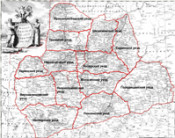
Independent Penza governorship established
As a result of administrative-territorial reforms of Peter I, May 29 (June 9), 1719 as a part of the Kazan governorate was established the Penza province, and within the reform of Catherine II, 15 (26) September 1780 was established an independent Penza governorship including 13 uyezds (districts): Verkhnelomovsky District, Gorodishchensky District, Insarsky District, Kerensky District, Krasnoslobodsky District, Mokshansky District, Narovchatsky District, Nizhnelomovsky District, Penza District, Saransk District, Troitsky District, Chembarsky District, Shishkeev District.
12 (23) December 1796 by imperial decree, "On a new division of the State by governorates," Penza governorship was transformed into the Penza governorate, which included, in addition, a part of the abolished Saratov province.
However, the new governorate lasted no more than three months. Under the Decree of 1797 "On establishing the county town of Saratov the principal town of the governorate," all the provincial administration was to be transferred from the city of Penza to Saratov. The governorate was to be called the Saratov governorate.”
Penza governorate was restored 9 (21) September 1801 when Alexander I signed the Decree "On the re-establishment of the five provinces and the subordination of border governorates to the military governors." Penza retained the newly obtained status of the provincial town up to the elimination of the provincial division in 1928.
When restoring the Penza governorate, Verkhnelomovsky, Troitsky and Sheshkeevsky districts were abolished, so the former district towns of Verkhny Lomov, Troitsk and Shishkeev received the status of unimportant. From 1801 the Penza governorate included 10 districts: Gorodishche, Insarsky, Kerensky, Krasnoslobodsky, Moksha, Narovchat, Nizhnelomovsky, Penza, Saransk and Chembarsky. By the time the Penza governorate covered an area of 33.4 km2 and its population numbered 353, 300 persons, of whom over 10, 000 were living in the principal town.
A great role in the formation of the governorate played Major General Filipp L. Vigel (1742—1812), who had governed the governorate from 1801 to 1809. His son Filipp F. Vigel noted: “The governor was the master of the governorate, defender of its rights, its intercessor at the throne”.
F. L. Vigel formed governorate and district governments, renovated government offices, and bought a mansion on the Upper (Cathedral) Square from the actual state councilor A. N. Kolokoltsov for his own residence. Since then, the house served as a permanent residence for the governors of Penza. In the neighboring two-story house adjacent to the governor’s one on the southern side, was the residence of vice-governors. Under the decree of the Governing Senate, experienced officials from Tambov, Kostroma, Tula, Simbirsk, Yaroslavl were appointed to serve in the new governing bodies.
5 (17) July 1878 was approved the coat of arms of the Penza governorate, which included elements of the ancient emblem of the city of Penza: "On the green shield there are three golden sheaves tied together with scarlet ribbons. The shield is crowned with an imperial crown and surrounded by golden oak leaves joined by Andrew's ribbon." The symbols of the coat of arms reflected the main scope of activities of inhabitants of the Penza province - agriculture.
After the revolution of 1917, the governorate’s composition underwent significant changes. In 1918, the Ruzaevsky District, a part of the Insarsky District, became an independent administrative unit, and in 1923 the Penza governorate included Temnikov and Spassky Districts of Tambov governorate. As a result of reforms of 1925, Insarsky, Kerensky, Moksha, Narovchat, Saransk and Temnikov Districts were abolished, the Ruzaevsky district was renamed to Saransk District, and Spassky District - to Bednodemyanovsky District.
May 14, 1928 the Penza Governorate and all its districts were abolished, and its territory became a part of Srednevolzhskaya Oblast.
Lit.: Атлас Грибовского рукописный. СПб, 1843; Вигель Ф. Ф. Записки. Ч. 1—7. М., 1891—1893; Пензенская энциклопедия. Пенза ; М., 2001; Самойлов Е. Г. Пензенский край в конце XVIII века. Пенза, 1959; Справочная книга Пензенской губернии на 1892 год. Пенза, 1892; Тюстин А. В. Пензенские губернаторы. Пенза, 2001; Хохряков В. Х. Открытие, упразднение и восстановление Пензенской губернии // Юбилейный сборник Пензенского губернского статистического комитета. Пенза, 1901.
Based on the Presidential Library’s materials:
Жданов М. П. Путевые записки по России, в двадцати губерниях. СПб., 1843;
Кузьмин И. Ф. Пензенская губерния. Пенза, 1895;
Памятная книжка Пензенской губернии на 1911 год. Пенза, 1911;
Полное собрание законов Российской империи, с 1649 года. СПб., 1830. Т. 20 (1775—1780). № 15061;
Списки населенных мест Российской империи. Т. 30. Пензенская губерния. СПб., 1869;
Стат Пензенского наместничества. СПб., 1780.
The material prepared in joint effort with the Lermontov Regional Library of Penza

